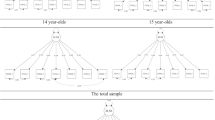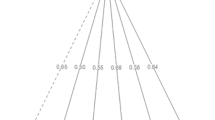Abstract
This research examined selected psychometric properties of the Students' Life Satisfaction Scale for groups of black and white elementary school students. Participants included 120 black children and 496 white children from grades 3–6. The findings failed to demonstrate racial bias with respect to reliability, factorial validity, or criterion-related validity.
Similar content being viewed by others
References
Balatsky, G. and E. Diener 1993, ‘Subjective Well-Being among Russian Students’, Social Indicators Research 28, pp. 225–243.
Campbell, A. 1981, The Sense of Well-Being in America: Recent Patterns and Trends (McGraw-Hill, New York).
Chamberlain, K. 1988, ‘On the Structure of Subjective Well-Being’, Social Indicators Research 20, pp. 581–604.
Clemente, F. and W. J. Sauer 1976, ‘Racial Differences in Life Satisfaction’, Journal of Black Studies 7, pp. 3–10.
Dew, T. and E. S. Huebner (in press), ‘Adolescents' Perceived Quality of Life: An Exploratory Investigation’, Journal of School Psychology.
Diener, E. 1984, ‘Subjective Well-Being’, Psychological Bulletin 95, pp. 542–575.
Diener, E. and M. Diener 1994, Cross-Cultural Correlates of Life Satisfaction and Self-Esteem (manuscript submitted for publication).
Diener, E., R. A. Emmons, R. J. Larsen and S. Griffin 1985, ‘The Satisfaction With Life Scale’, Journal of Personality Assessment 49, pp. 71–75.
Diener, E. and R. J. Larsen 1993, ‘The Experience of Emotional Well-Being’, in M. Lewis and J. M. Haviland (eds.), The Handbook of Emotions (Guilford, New York), pp. 405–415.
Feldt, L. S. 1969, ‘A Test of the Hypothesis that Cronbach's Alpha or Kuder-Richardson Coefficient Twenty Is the Same for Two Tests’, Psychometrika 34, pp. 363–373.
Frisch, M. B., J. Comell, M. Villanueva and P. J. Retzlaff 1992, ‘Clinical Validation of the Quality of Life Inventory: A Measure of Life Satisfaction for Use in Treatment Planning and Outcome Assessment’, Psychological Assessment 4, pp. 92–101.
Harman, H. 1976, Modern Factor Analysis (2nd ed.) (University of Chicago Press, Chicago).
Huebner, E. S. (in press), Preliminary Development and Validation of a Multidimensional Life Satisfaction Scale for Children Psychological Assessment.
Huebner, E. S. 1991a, ‘Initial Development of the Students' Life Satisfaction Scale’, School Psychology International 12, pp. 231–240.
Huebner, E. S. 1991b, ‘Correlates of Life Satisfaction in Children’, School Psychology Quarterly 6, pp. 103–111.
Huebner, E. S. 1991c, ‘Further Validation of the Students' Life Satisfaction Scale: The Independence of Satisfaction and Affect Ratings’, Journal of Psychoeducational Assessment 9, pp. 363–368.
Huebner, E. S. and G. Alderman 1993, ‘Convergent and Discriminant Validation of a Children's Life Satisfaction Scale: Its Relationship to Self- and Teacher-Reported Psychological Problems and School Functioning’, Social Indicators Research 30, pp. 71–82.
Huebner, E. S. and T. Dew 1993a, ‘An Evaluation of Racial Bias in a Life Satisfaction Scale’, Psychology in the Schools 30, pp. 305–309.
Huebner, E. S. and T. Dew 1993b, ‘Validity of the Perceived Life Satisfaction Scale’, School Psychology International 14, pp. 355–360.
Lewinsohn, P., J. Redner and J. Seeley 1991, ‘The Relationship Between Life Satisfaction and Psychosocial Variables: New Perspectives’, in F. Strack, M. Argyle and N. Schwartz (eds.), Subjective Well-Being (Plenum Press, New York), pp. 141–169.
Marsh, H. W. 1990, Self-Description Questionnaire-I, Available from: University of Western Sydney, Macarthur, P.O. Box 555, Campbelltown N.S.W. 2560, Australia.
Moran, M. P. 1990, ‘The Problem of Cultural Bias in Personality Assessment’, in C. R. Reynolds and R. W. Kamphaus (eds.), Handbook of Psychological and Educational Assessment of Children: Personality, Behavior, and Context (Guilford, New York), pp. 524–545.
Neugarten, B. L., R. J. Havighurst and S. S. Tobin 1961, ‘The Measurement of Life Satisfaction’, Journal of Gerontology 16, pp. 134–143.
Pavot, W. and E. Diener 1993, ‘Review of the Satisfaction With Life Scale’, Psychological Assessment 5, pp. 164–172.
Reynolds, C. R. and S. M. Kaiser 1990, ‘Bias in Assessment of Aptitude’, in C. R. Reynolds and R. W. Kamphaus (eds.), Handbook of Psychological and Educational Assessment of Children: Personality, Behavior, and Context (Guilford, New York), pp. 611–653.
Salamon, M. J. 1988, ‘Clinical Use of the Life Satisfaction in the Early Scale’, Clinical Gerontologist 8, pp. 45–54.
Tabachnick, B. G. and L. S. Fidell 1989, Using Multivariate Statistics (2nd ed.) (Harper Collins Publishers, New York).
Terry, T. and E. S. Huebner 1994, The Relationship Between Self-Concept and Life Satisfaction among Children (manuscript submitted for publication).
Veenhoven, R. 1984, Conditions of Happiness (Reidel, The Netherlands).
Rights and permissions
About this article
Cite this article
Huebner, E.S. The Students' Life Satisfaction Scale: An assessment of psychometric properties with black and white elementary school students. Soc Indic Res 34, 315–323 (1995). https://doi.org/10.1007/BF01078690
Accepted:
Issue Date:
DOI: https://doi.org/10.1007/BF01078690




